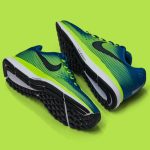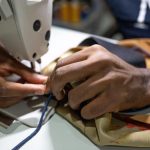Are you curious about what fabric is used in Nike Swoosh leather? Look no further! This article will provide you with valuable information on the importance of fabric in Nike Swoosh leather, its composition, different types of fabrics used, and tips on identifying and choosing the right fabric.
We will also explore the durability, performance, care, and maintenance of different fabric options.
Get ready to dive into the world of fabric technology in Nike Swoosh leather!
Table of Contents
The Importance of Fabric in Nike Swoosh Leather
The fabric on a Nike Swoosh leather is crucial for its overall quality and durability. When it comes to leather quality, Nike ensures that only the finest materials are used for their products. The fabric used in their Swoosh leather is carefully selected to enhance the leather’s strength and longevity. Nike understands that a strong fabric backing is essential for maintaining the shape and structure of the leather, especially in high-stress areas like the Swoosh logo.
In addition to leather quality, Nike is also committed to material sustainability. They strive to use eco-friendly fabrics that have a minimal impact on the environment. By choosing sustainable materials for their Swoosh leather, Nike demonstrates their dedication to reducing waste and preserving natural resources. This commitment to sustainability not only benefits the environment but also ensures that their products are made to last.
Understanding the Composition of Nike Swoosh Leather
When it comes to understanding the composition of Nike Swoosh Leather, there are three key points to consider.
Firstly, the leather sourcing process is crucial in determining the quality and sustainability of the material.
Secondly, durability and longevity play a significant role in assessing the overall value and performance of the leather.
Lastly, an environmental impact assessment is necessary to evaluate the ecological footprint of the leather production process.
Leather Sourcing Process
Leather for Nike’s swoosh is sourced through a careful process. The company faces various challenges in leather sourcing, including ensuring sustainability efforts are met. Nike strives to source leather from suppliers who adhere to strict animal welfare standards and environmental regulations. The company also supports the Leather Working Group (LWG), an organization that promotes responsible environmental practices within the leather industry. By partnering with LWG-certified tanneries, Nike ensures that the leather used in their products is produced in a sustainable and ethical manner. The table below provides an overview of Nike’s leather sourcing process, highlighting the steps involved and the sustainability initiatives incorporated.
| Step | Description | Sustainability Initiatives |
|---|---|---|
| Supplier Selection | Thorough evaluation of suppliers | Adherence to animal welfare and environmental standards |
| Tannery Inspection | On-site visits and audits | Leather Working Group (LWG) certification |
| Traceability | Tracking the origin of the leather | Transparency and accountability throughout the supply chain |
Through these efforts, Nike ensures that the leather used in their swoosh symbol is not only of high quality but also sourced in a responsible and sustainable manner.
Durability and Longevity
To ensure your products last a long time, Nike prioritizes durability and longevity in their sourcing and manufacturing processes.
One key aspect of this is fabric strength. Nike carefully selects and tests fabrics that are known for their strength and ability to withstand wear and tear. By using strong fabrics, Nike can create products that can endure the demands of athletic activities and everyday use.
This focus on durability does have an impact on pricing, as high-quality, durable fabrics often come at a higher cost. However, Nike believes that investing in quality materials is worth it, as it ensures that their products will last longer and provide better performance.
Environmental Impact Assessment
One way that Nike assesses its environmental impact is by carefully selecting and testing materials known for their sustainability. The company recognizes the need to reduce its reliance on leather and has been actively exploring leather alternatives that are more environmentally friendly.
Nike is committed to sustainable sourcing, ensuring that the materials used in its products are responsibly produced and do not harm the environment. By using sustainable materials, Nike aims to minimize its carbon footprint and contribute to a more sustainable future.
Through extensive research and testing, Nike is continuously striving to develop innovative solutions that offer the same performance and quality as traditional leather, while reducing the environmental impact of its products. By incorporating leather alternatives and sourcing materials sustainably, Nike is taking significant steps towards creating a more environmentally friendly and socially responsible brand.
Different Types of Fabrics Used in Nike Swoosh Leather
When it comes to choosing between leather and synthetic fabrics for your Nike Swoosh Leather products, there are a few key points to consider.
First, durability and performance are important factors to think about. While leather is known for its strength and longevity, synthetic fabrics can also offer durability and resistance to wear and tear.
Second, style and versatility play a role in your decision-making process. Leather has a classic and timeless look, while synthetic fabrics can provide a wider range of colors and textures to choose from.
Ultimately, the choice between leather and synthetic fabrics depends on your personal preferences and the specific needs of your Nike Swoosh Leather products.
Leather Vs. Synthetic Fabrics
Leather and synthetic fabrics have different characteristics that make them suitable for different purposes. Here’s a comparison to help you understand their qualities and impacts on fabric quality and sustainability:
-
Durability: Leather is known for its strength and longevity, making it a top choice for products that require durability, like shoes and bags. Synthetic fabrics, on the other hand, may not be as durable and can wear out faster.
-
Breathability: Leather allows air to pass through, making it more breathable compared to synthetic fabrics that can trap heat and moisture.
-
Sustainability: Leather production has a significant environmental impact, as it requires the use of animal hides and chemicals. Synthetic fabrics, although not without their own sustainability challenges, can be made from recycled materials and reduce the demand for animal products.
-
Versatility: Synthetic fabrics offer a wide range of options in terms of colors, patterns, and textures, while leather has a timeless and classic appeal.
Consider these factors when choosing between leather and synthetic fabrics, considering both fabric quality and sustainability impact.
Durability and Performance
When choosing between leather and synthetic fabrics for athletic wear, it is important to consider durability and performance.
Both materials undergo durability testing to ensure their quality and longevity. Leather is known for its durability and ability to withstand wear and tear, making it a popular choice for athletic shoes and gear. It provides excellent support and protection, allowing athletes to perform at their best.
Synthetic fabrics, on the other hand, are engineered to be lightweight, breathable, and flexible, providing enhanced comfort and movement. While they may not have the same level of durability as leather, they can still withstand the demands of athletic activities.
Ultimately, the choice between leather and synthetic fabrics depends on personal preference and the specific needs of the athlete.
Stylish and Versatile
If you’re looking for a stylish and versatile option, consider synthetic athletic wear for its wide range of colors and designs. Synthetic fabrics like polyester and nylon are known for their durability and performance, making them perfect for athletic activities.
Here are four reasons why synthetic athletic wear is a great choice for fashion and trends:
-
Versatility: Synthetic fabrics can be easily dyed, allowing for a wide range of colors and designs. This means you can find athletic wear that perfectly matches your personal style.
-
Durability: Synthetic fabrics are known for their strength and resistance to wear and tear. This means your athletic wear will last longer, even with frequent use.
-
Moisture-wicking: Synthetic fabrics are designed to wick away moisture from your body, keeping you dry and comfortable during workouts.
-
Quick-drying: Synthetic fabrics dry quickly, so you don’t have to worry about being uncomfortable in damp clothes after a workout.
With its versatility and durability, synthetic athletic wear is a fashionable choice that will keep up with the latest trends while providing the performance you need.
How to Identify the Fabric in a Nike Swoosh Leather
To identify the fabric in a Nike Swoosh leather, you can simply look at the tag attached to the product. The tag will provide you with important information about the type of fabric used in the construction of the leather. Nike takes great care in selecting the right fabric for their products, ensuring that they meet the highest quality standards. When it comes to identifying fabric types, Nike follows a meticulous fabric selection process.
The fabric selection process at Nike involves considering various factors such as durability, comfort, and performance. Nike aims to provide customers with products that are not only stylish but also functional. They carefully choose fabrics that can withstand the demands of athletic activities while also providing a comfortable fit.
In addition to the tag, you can also examine the texture and appearance of the Nike Swoosh leather to get an idea of the fabric used. Leather materials may vary in terms of texture and finish, and Nike offers a range of options to suit different preferences.
Overall, identifying the fabric in a Nike Swoosh leather is a straightforward process. By checking the tag and examining the texture and appearance, you can determine the type of fabric used and make an informed decision about your purchase.
Factors to Consider When Choosing the Fabric for Nike Swoosh Leather
Consider important factors like durability, comfort, and performance when selecting the fabric for your Nike Swoosh leather. The fabric you choose will not only affect the overall look of your sneakers but also impact their functionality and longevity.
Here are four key factors to consider when deciding on the fabric for your Nike Swoosh leather:
-
Durability: Opt for a fabric that can withstand daily wear and tear. Look for materials such as genuine leather or synthetic leather that are known for their durability and ability to resist scuffs and scratches.
-
Comfort: Choose a fabric that provides a comfortable fit. Look for materials that are soft, flexible, and breathable, such as mesh or suede, to ensure maximum comfort during long hours of wear.
-
Performance: Consider the performance features you desire. If you plan on using your Nike Swoosh leather sneakers for athletic activities, prioritize fabrics that offer moisture-wicking properties, like synthetic materials or engineered mesh, to keep your feet dry and comfortable.
-
Style: Finally, think about the aesthetic appeal of different fabric options. Consider the look and feel you want to achieve and choose a fabric that complements your personal style and preferences.
The Durability and Performance of Different Fabric Options for Nike Swoosh Leather
When choosing the right fabric for your Nike Swoosh leather sneakers, it’s important to prioritize durability and performance. The fabric used in the design of your sneakers can greatly impact their overall quality and longevity. To help you make an informed decision, let’s take a look at the durability testing and fabric performance evaluation of different options.
| Fabric | Durability Rating | Performance Rating |
|---|---|---|
| Cotton | High | Moderate |
| Polyester | Moderate | High |
| Nylon | High | High |
| Canvas | High | High |
| Synthetic | High | High |
Durability testing involves subjecting the fabric to various conditions, such as abrasion, flexing, and moisture exposure, to assess its strength and resilience. Fabric performance evaluation focuses on factors like breathability, moisture-wicking abilities, and overall comfort. Based on the table above, cotton offers high durability but only moderate performance. Polyester, on the other hand, has moderate durability but high performance. Nylon, canvas, and synthetic fabrics all score high in both durability and performance.
Ultimately, the choice of fabric for your Nike Swoosh leather sneakers depends on your specific needs and preferences. Consider the durability and performance ratings of each fabric option to ensure that your sneakers will withstand the test of time while providing the level of comfort and functionality you desire.
Care and Maintenance Tips for Nike Swoosh Leather With Various Fabrics
Now that you know about the durability and performance of different fabric options for Nike Swoosh leather, it’s important to learn how to care for and maintain your Nike Swoosh leather with various fabrics.
Here are some care tips and cleaning methods to keep your Nike Swoosh leather looking its best:
-
Regular cleaning: Wipe the leather with a soft, damp cloth to remove any dirt or dust. Avoid using harsh chemicals or excessive water, as it can damage the leather.
-
Condition regularly: Apply a leather conditioner to keep the leather moisturized and prevent it from drying out or cracking. Follow the instructions on the conditioner for best results.
-
Spot cleaning: For small stains or spills, use a mild soap or leather cleaner and a soft cloth to gently clean the affected area. Blot the stain instead of rubbing it to prevent spreading.
-
Professional cleaning: If your Nike Swoosh leather requires deep cleaning or if you’re unsure about the cleaning process, it’s best to take it to a professional leather cleaner. They have the expertise and tools to safely clean and restore the leather.
Exploring the Future of Fabric Technology in Nike Swoosh Leather
To stay ahead of the game, you should keep an eye on the advancements in fabric technology that will shape the future of Nike Swoosh leather. The future of fabric technology holds great promise for Nike Swoosh leather, bringing exciting developments and sustainability measures.
As technology continues to advance, we can expect to see improvements in the durability, comfort, and performance of Nike Swoosh leather.
Future advancements in fabric technology will enable Nike to create even lighter and more breathable materials for their Swoosh leather products. With improved breathability, your feet will stay cool and comfortable, even during intense workouts or long hours of wear. Additionally, advancements in fabric technology will enhance the durability of Nike Swoosh leather, ensuring that your shoes last longer and can withstand various environments and activities.
Sustainability measures will also play a significant role in shaping the future of Nike Swoosh leather. As consumers become increasingly conscious of the environmental impact of their purchases, Nike is committed to finding innovative ways to reduce waste and minimize their carbon footprint. This includes exploring sustainable materials and manufacturing processes that will make Nike Swoosh leather more environmentally friendly without compromising on performance or style.
Conclusion
In conclusion, understanding the fabric composition of Nike Swoosh leather is crucial in choosing the right option for your needs. By identifying the fabric and considering factors like durability and performance, you can make an informed decision.
Remember to follow proper care and maintenance tips to prolong the lifespan of your Nike Swoosh leather.
As fabric technology continues to advance, we can expect exciting developments in the future of Nike Swoosh leather. Stay updated and embrace the possibilities of innovative fabric options.
- How Does Ring Spun Cotton Affect Garment Fit and Shape Retention? - August 13, 2024
- What Are the Challenges in Producing Ring Spun Cotton? - August 13, 2024
- Is Ring Spun Cotton Suitable for Plus-Size Clothing? - August 13, 2024






